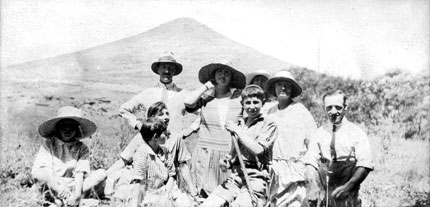
Geology
The Strath Taieri is a classic basin-and-range landscape, formed of old rocks and young mountains. The schist bedrock is up to 200 million years old but the mountain ranges flanking the valley – the Rock and Pillar Range to the west and the Taieri Ridge to the east – are geologically young, only about three million years old. They have been thrust up by tectonic forces along parallel faults. Erosion of the ancient surfaces has left the harder, quartz-rich outcrops of schist exposed as tors. The tor formations at Sutton and on the top of the 23-km long Rock and Pillar summit crest are among the most striking in Otago.
Although the Strath Taieri may appear to be a U-shaped glaciated valley, it never hosted a glacier during the ice ages. About 20 million years ago, volcanic activity peppered the landscape with cones and craters, one of which, The Redan, has been hoisted up on the Taieri Ridge over the past three million years. Its black rim of basalt is now an eye-catching sight from the Middlemarch-Hyde road and from the Otago Central Rail Trail.
Other volcanic features are Smooth Cone both near Middlemarch and The Sisters on Taieri Ridge.
At Foulden Hill, near Smooth Cone, is a nationally significant deposit of diatomite, which was formed in a crater lake from the silicon skeletal remains of eons of microscopic water-borne diatoms. Leaves of many species of now-extinct trees are preserved as fossils in the diatomite.
- The Redan
- Smooth Cone
- Sutton Salt Lake
- The Two Sisters
- Diatomaceous Earth
- Schist Tors
Smooth Cone
A landscape feature that is hard to ignore when arriving in the Strath Taieri. The extraordinary visual symmetry of this small cone is the same from all angles.

An early photo of Smooth Cone
The relatively soft rock of the lower slopes has been worn by wind and rain. Smooth Cone is topped by a cluster of basalt boulders, which are remnants from the old Dunedin volcano.
The summit is adorned with a lone radiata pine, which has a story of its own.
On Friday, 8 November 1918, Middlemarch celebrated Germany's surrender, four days before the actual signing of the Armistice. Bells rang out, children were let out of school, speeches were made and the brass band played. When Dunedin caught up the following Tuesday, Middlemarch did it all again.
It was during this second celebration of peace that the Armistice Tree was planted, despite protestations that nothing would grow there.
Between the boulders grew the tree seen today, having survived swarming rabbits and roaring gales from every direction. Its giant roots find their way over the surface of the rock for up to six metres before diving into the soil. This short, solid tree is firmly braced to cope with the worst of gales, and stands out for all to see - a reminder of Armistice Day 1918.
Sutton Salt Lake
- See also Walks
